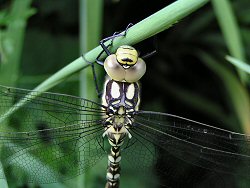Sometimes it only takes one visiting animal to turn a day into a red-letter day. An unexpected encounter with a southern hawker did that for me this weekend.
 Immature southern hawker Aeshna cyanea in the garden.
Immature southern hawker Aeshna cyanea in the garden.
I could so easily have missed it. I was having a cup of tea at the back of the garden and I glanced up to catch a glimpse of what seemed like a dragonfly alighting in vegetation some 20 feet away from me. I had only caught a glimpse of it and I couldn't be sure that it was not a damselfly, but my instant feeling was that it was too robust for a damselfly. I approached the spot where it had gone down - nothing flew. I sat quietly down and carefully scanned the vegetation, at first seeing nothing; but then, quite suddenly, I saw it no more than three feet from me. So big, but so inconspicuous against the vegetation.
I would have been thrilled to see any dragonfly in the garden - particularly this early in the year - but this one turned out to be doubly exciting. This was a southern hawker (
Aeshna cyanea) - the broad antehumeral stripes (so broad they look more like spots) behind the eyes and other aspects of its patterning are diagnostic. Lancashire is getting towards the north of this species' range, so it was a nice dragonfly to see. Even more interesting was the uniformly pale cream colour of this specimen which indicated that it was immature - no more than a few days old. This raises the possibility that it had emerged from my own pond. I searched in vain for its exuvia on pond-side vegetation, but it could easily be concealed there somewhere.
Southern hawkers are known to be attracted to urban areas including garden ponds, perhaps because gardens resemble its more natural habitat of woodland clearings (see
Brooks and Lewington 1997).